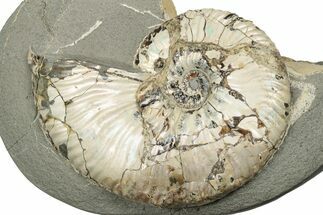This Specimen has been sold.
5.1" Fossil Horsetail (Calamites) in Ironstone - Illinois
This is a 5.1" fossil horsetail (Calamites suckowi) stalk from the Carbondale Formation near Coal City, Illinois. It is preserved within an ironstone nodule. It comes with an acrylic display stand.
Calamites is a genus of extinct arborescent (tree-like) horsetails to which the modern horsetails are closely related. Unlike their modern cousins, these plants were medium-sized trees, growing to heights of more than 30 meters (100 feet). They were components of the understories of coal swamps of the Carboniferous Period.
The trunks of Calamites had a distinctive segmented, bamboo-like appearance and vertical ribbing. The branches, leaves and cones were all borne in whorls. The leaves were needle-shaped, with up to 25 per whorl.
The stems of modern horsetails are typically hollow or contain numerous elongated air-filled sacs. Calamites was similar in that its trunk and stems were hollow, like wooden tubes. When these trunks buckled and broke, they could fill with sediment. This is the reason pith casts of the inside of Calamites stems are so common as fossils. Calamites would have been covered with a thin outer bark but this is almost never preserved.
Calamites is a genus of extinct arborescent (tree-like) horsetails to which the modern horsetails are closely related. Unlike their modern cousins, these plants were medium-sized trees, growing to heights of more than 30 meters (100 feet). They were components of the understories of coal swamps of the Carboniferous Period.
The trunks of Calamites had a distinctive segmented, bamboo-like appearance and vertical ribbing. The branches, leaves and cones were all borne in whorls. The leaves were needle-shaped, with up to 25 per whorl.
The stems of modern horsetails are typically hollow or contain numerous elongated air-filled sacs. Calamites was similar in that its trunk and stems were hollow, like wooden tubes. When these trunks buckled and broke, they could fill with sediment. This is the reason pith casts of the inside of Calamites stems are so common as fossils. Calamites would have been covered with a thin outer bark but this is almost never preserved.
SPECIES
Calamites suckowi
LOCATION
Coal City, Illinois
FORMATION
Carbondale Formation
SIZE
5.1 x 3.9" nodule
CATEGORY
SUB CATEGORY
ITEM
#136648
We guarantee the authenticity of all of our specimens.
 Reviews
Reviews












